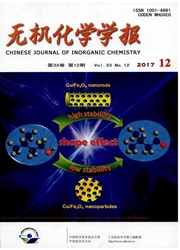

 中文摘要:
中文摘要:
运用基于密度泛函理论的第一性原理方法,建立了SnO2以及不同比例Ru掺杂的SnO2超胞模型,在对其进行几何优化后计算了Sn1-xRuxO2(x=0,1/16,1/12,1,8,1/6,1/4,1/2)半导体的电子结构,并讨论了其晶格参数、电荷密度、能带结构和态密度(包括分态密度)等性质。结果表明,掺杂后,晶格参数随掺杂量的增加线性减小,与实验值的偏差在4%1)2内;掺杂后,在费米能级处可以提供更多的填充电子,使得电子跃迁至导带更容易,固溶体的导电性增强。为Sn1-xRuxO2固溶体电极材料的发展和应用提供了理论基础。
 英文摘要:
英文摘要:
Ru-doped Sn02 semiconductor is a significant component of titanium based oxide acid-resistant anode. Using the first-principle method based on the density functional theory, crystal cells were built, which include Sn02 and variety proportions of Ru-doped Sn02, and electronic structures of Sn1-xRuxO2 semiconductor (x=0, 1/16, 1/12, 1/8, 1/6, 1/4, 1/2) were calculated after geometry optimization. Lattice parameters, electron density, band structure, and density of states are discussed. The results show that the corresponding lattice parameters reduce linearly with composition and the errors between calculated and experimental values of that are within 4%; in addition, the number of electrons filled at the bottom of the conduction band increases after doping, resulting in the strengthening of the conductivity of the solid solution after doping of Ru. The results provide a theoretical basis for the development and application of the Sn1-xRuxO2 solid solutions electrode.
 同期刊论文项目
同期刊论文项目
 同项目期刊论文
同项目期刊论文
 Electronic structures and optical properties of transition metals (Fe, Co, Ni, Zn) doped rutile TiO2
Electronic structures and optical properties of transition metals (Fe, Co, Ni, Zn) doped rutile TiO2 Preparation and photocatalytic properties of ilmenite NiTiO3 powders for degradation of humic acid i
Preparation and photocatalytic properties of ilmenite NiTiO3 powders for degradation of humic acid i A dual chelating sol-gel synthesis of BaTiO3 nanoparticles with effective photocatalytic activity fo
A dual chelating sol-gel synthesis of BaTiO3 nanoparticles with effective photocatalytic activity fo First-principles investigation of impurity concentration influence on bonding behavior, electronic s
First-principles investigation of impurity concentration influence on bonding behavior, electronic s First-principles study on the structural, electronic and optical properties of BiOX (X=Cl, Br, I) cr
First-principles study on the structural, electronic and optical properties of BiOX (X=Cl, Br, I) cr Low temperature one-step synthesis of rutile TiO2/BiOCl composites with enhanced photocatalytic acti
Low temperature one-step synthesis of rutile TiO2/BiOCl composites with enhanced photocatalytic acti Facile preparation of Sn-doped BiOCl photocatalyst with enhanced photocatalytic activity for benzoic
Facile preparation of Sn-doped BiOCl photocatalyst with enhanced photocatalytic activity for benzoic DFT+U predictions: The effect of oxygen vacancy on the structural, electronic and photocatalytic pro
DFT+U predictions: The effect of oxygen vacancy on the structural, electronic and photocatalytic pro Synthesis of BiOCl photocatalyst by a low-cost, simple hydrolytic technique and its excellent photoc
Synthesis of BiOCl photocatalyst by a low-cost, simple hydrolytic technique and its excellent photoc Effect of light response on the photocatalytic activity of BiOCl (x) Br1-x in the removal of Rhodami
Effect of light response on the photocatalytic activity of BiOCl (x) Br1-x in the removal of Rhodami One-step synthesis of porous BiOBrfilm and Bi nanopowder simultaneously from Bi plate via electroche
One-step synthesis of porous BiOBrfilm and Bi nanopowder simultaneously from Bi plate via electroche Photocatalytic degradation of carbamazepine using hierarchical BiOClmicrospheres: Some key operating
Photocatalytic degradation of carbamazepine using hierarchical BiOClmicrospheres: Some key operating Effect of chlorine ion on the crystalline and photocatalytic activityof BiOCl for the degradation of
Effect of chlorine ion on the crystalline and photocatalytic activityof BiOCl for the degradation of An in vitro study on the cytotoxicity of bismuth oxychloride nanosheets in human HaCaT keratinocytes
An in vitro study on the cytotoxicity of bismuth oxychloride nanosheets in human HaCaT keratinocytes Rapid synthesis of hierarchical BiOCl microspheres for efficient photocatalytic degradation of carba
Rapid synthesis of hierarchical BiOCl microspheres for efficient photocatalytic degradation of carba A BiPO4/BiOCl heterojunction photocatalyst with enhanced electron-hole separation and excellent phot
A BiPO4/BiOCl heterojunction photocatalyst with enhanced electron-hole separation and excellent phot A facile approach for the tunable fabrication of BiOBr photocatalysts with high activity and stabili
A facile approach for the tunable fabrication of BiOBr photocatalysts with high activity and stabili One-pot hydrothermal synthesis of a novel BiPO4/BiOBrcomposite with enhanced visible light photocata
One-pot hydrothermal synthesis of a novel BiPO4/BiOBrcomposite with enhanced visible light photocata Comparative toxicities of bismuth oxybromide and titanium dioxideexposure on human skin keratinocyte
Comparative toxicities of bismuth oxybromide and titanium dioxideexposure on human skin keratinocyte Double Br sources fabrication and photocatalytic property of p-n junction BiOBr/ZnO composites for p
Double Br sources fabrication and photocatalytic property of p-n junction BiOBr/ZnO composites for p Effect of chlorine ion on the crystalline and photocatalytic activity of BiOCl for the degradation o
Effect of chlorine ion on the crystalline and photocatalytic activity of BiOCl for the degradation o RhB-sensitized effect on the enhancement of photocatalytic activity of BiOCl toward bisphenol-A unde
RhB-sensitized effect on the enhancement of photocatalytic activity of BiOCl toward bisphenol-A unde Theoretical calculation and experimental study on the conductivity and stability of Bi-doped SnO2 el
Theoretical calculation and experimental study on the conductivity and stability of Bi-doped SnO2 el Electrochemical synthesis of flower shaped morphology MOFs in an ionic liquid system and their elect
Electrochemical synthesis of flower shaped morphology MOFs in an ionic liquid system and their elect First-principle study of electronic, structural properties and stability of Sn0.5M0.5O2, M=Ti, Mn, S
First-principle study of electronic, structural properties and stability of Sn0.5M0.5O2, M=Ti, Mn, S Electrochemical synthesis of trimethylamine by cathodic reductionof dimethylformamide using Cu and P
Electrochemical synthesis of trimethylamine by cathodic reductionof dimethylformamide using Cu and P Experimental study and theoretical calculation on the conductivity and stability of praseodymium dop
Experimental study and theoretical calculation on the conductivity and stability of praseodymium dop 期刊信息
期刊信息
